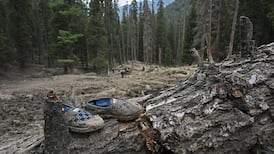US secretary of state has John Kerry visited the Hiroshima memorial, delivering a message of peace and hope for a nuclear-free world seven decades after an atomic bomb killed in the city.
Mr Kerry became the most senior American official to travel to the city, touring its peace museum with other foreign ministers of the G7 industrialised nations and laying a wreath at the adjoining park's stone-arched monument.
The otherwise sombre occasion was lifted by the presence of about 800 Japanese people waving flags of the G7 countries, including that of the United States.
Mr Kerry did not speak publicly at the ceremony, though he could be seen with his arm around Japanese foreign minister Fumio Kishida, a Hiroshima native, and whispering in his ear.
“Everyone in the world should see and feel the power of this memorial,” Mr Kerry wrote in the museum’s guest book.
“It is a stark, harsh, compelling reminder not only of our obligation to end the threat of nuclear weapons, but to rededicate all our effort to avoid war itself.
“War must be the last resort - never the first choice,” he added.
“This memorial compels us all to redouble our efforts to change the world, to find peace and build the future so yearned for by citizens everywhere.”
Mr Kerry’s appearance, just footsteps away from Ground Zero, completed an evolution for the United States, whose leaders avoided the city for many years because of political sensitivities.
No serving US president has visited the site, and it took 65 years for a US ambassador to attend Hiroshima’s annual memorial service.
Many Americans believe the dropping of atomic bombs there on August 6th, 1945, and on the Japanese city of Nagasaki three days later, were justified and hastened the end of the war.
Nevertheless, Japanese survivors’ groups have campaigned for decades to bring leaders from the US and other nuclear powers to see Hiroshima’s scars as part of a grassroots movement to abolish nuclear weapons.
As Mr Kerry expressed interest, neither Japanese government officials nor survivor groups pressed for the US to say sorry. A senior American official travelling with Mr Kerry confirmed that no apology would occur.
Shortly before the ceremony, Mr Kerry called it “a moment that I hope will underscore to the world the importance of peace and the importance of strong allies working together to make the world safer and, ultimately, we hope to be able to rid the world of weapons of mass destruction”.
As he met Mr Kishida, Mr Kerry added: “And while we will revisit the past and honour those who perished, this trip is not about the past.
“It’s about the present and the future particularly, and the strength of the relationship that we have built, the friendship that we share, the strength of our alliance and the strong reminder of the imperative we all have to work for peace for peoples everywhere.”
US president Barack Obama may travel to Hiroshima next month.
The president has not made a final decision about visiting the city and its memorial when he attends a G7 meeting in central Japan in late May. During his first year in office, Mr Obama said he would be "honoured" to do so.
The museum includes harrowing images of the destruction and shocking exhibits, including the torn clothing of children who perished and skin, fingernails, deformed tongues and other examples of the exposure to the blast and its residual radiation.
Some explanations mounted on the wall, however, do not align with the views of all historians and experts in the United States or elsewhere.
For example, one suggests that the US used the weapon in part to justify the extraordinary costs of the Manhattan Project to develop it. Disagreements over motivations and possible justifications rage among historians, ethicists and others to this day.
PA








